

The Palazzo Flangini is a Baroque style palace on the Grand Canal, located adjacent to Campo San Geremia in the sestiere of Cannaregio in Venice, Italy.


The Palazzo Flangini is a Baroque style palace on the Grand Canal, located adjacent to Campo San Geremia in the sestiere of Cannaregio in Venice, Italy.
The palace was constructed in 1664–1682 to a design attributed to the architect Giuseppe Sardi. Others have incorrectly attributed the design to his mentor Baldassare Longhena. The palace was built by the Flangini family, a Greek Cypriot family in Venice. One of their members, Thomas Flanginis, in 1626 was the patron for the Flanginian school, a Greek school in Venice. The last of the family to own the palace was the cardinal Luigi or Ludovico Flangini (died 1804). [1] By the end of the 18th century, the palace was occupied by the Panciera family. The palace is asymmetric; it is surmised that at some time the family was unable to purchase the adjacent property and that the original plans called for a palace of twice the size. [2] [3]

The Grand Canal is the largest channel in Venice, Italy, forming one of the major water-traffic corridors in the city.
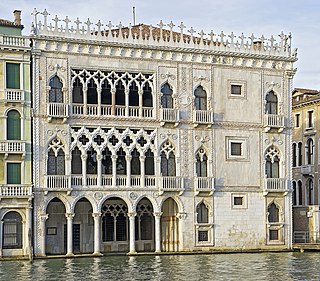
The Ca' d'Oro, or Palazzo Santa Sofia, is a palace on the Grand Canal in Venice, northern Italy. Ca' d'Oro or Cadoro translates to "House of Gold" or "Golden House" in English because of the gilt and polychrome external decorations that once adorned its walls. It was designed by Marino Contarini and later restored by Baron Giorgio Franchetti. In 1927, the building was converted into a museum and since then has been known as the Galleria Giorgio Franchetti alla Ca' d'Oro.

Ca' Foscari, the palace of the Foscari family, is a Gothic building on the waterfront of the Grand Canal in the Dorsoduro sestiere of Venice, Italy.

Palazzo Barbarigo is a palace situated facing the Grand Canal of Venice, Italy. It is not to be confused with the Palazzo Barbarigo Minotto and Palazzo Barbarigo della Terrazza, both also on the Grand Canal, and other palazzi, and several villas, once owned by the Barbarigo family.

Palazzo Grassi is a building in the Venetian Classical style located on the Grand Canal of Venice (Italy), between the Palazzo Moro Lin and the campo San Samuele.
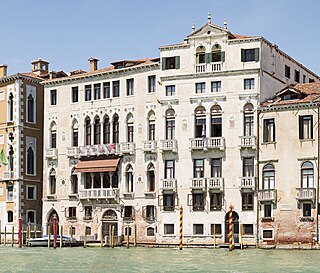
The Palazzi Barbaro—also known as Palazzo Barbaro, Ca' Barbaro, and Palazzo Barbaro-Curtis—are a pair of adjoining palaces, in the San Marco district of Venice, northern Italy. They were formerly one of the homes of the patrician Barbaro family. The Palazzi are located on the Grand Canal of Venice, next to the Palazzo Cavalli-Franchetti and not far from the Ponte dell'Accademia. The buildings are also known as the Palazzo Barbaro-Curtis. It is one of the least altered of the Gothic palaces of Venice.
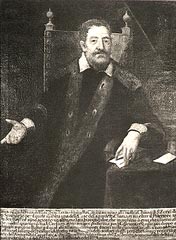
Thomas Flanginis was a wealthy Greek lawyer and merchant in Venice, who founded the Flanginian School, a Greek college where many teachers were trained. The ‘Flanginian School’ established by Thomas Flanginis remained a renowned establishment for several centuries. He owned the Palazzo Flangini in Venice.

The Grand Canal in Venice from Palazzo Flangini to Campo San Marcuola is a painting by Canaletto in the J. Paul Getty Museum in Los Angeles, California. Painted around 1738, it may have been commissioned by the English merchant and art collector Joseph Smith (1682–1770).

Palazzo Corner della Ca' Granda, also called Ca' Corner della Ca' Granda or simply Palazzo Corner or Palazzo Cornaro, is a Renaissance-style palace located between the Casina delle Rose and the Rio di San Maurizio (Venice), across the Grand Canal from the Palazzo Venier dei Leoni, in the city of Venice, Italy. It is the current seat of the province of Venice and of the city's prefect.
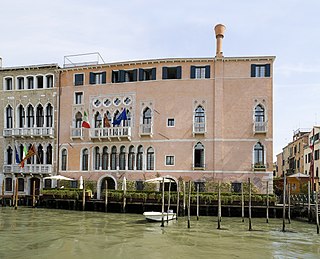
The Ca' Sagredo is a 14th-century Byzantine-Gothic style palace located on the corner of the Strada Nuova and Campo Santa Sofia, in the sestiere of Cannaregio in central Venice, Italy. It now faces the Grand Canal (Venice), and across the campo from the Ca' Foscari. On the left side there is the Palazzo Giustinian Pesaro.

The Palazzo Soranzo is composed of two adjacent Gothic palaces or palazzi, located facing Campo San Polo, in the sestiere San Polo of Venice, Italy. There is a distinct Palazzo Soranzo Piovene on the Grand Canal of Venice.

Palazzo Corner della Regina, commonly known as Ca' Corner della Regina, is a Baroque-style palace in the Sestiere Santa Croce of the city of Venice, Italy. In the English language, the title conforms with Palace of the Queen from the "Corner Family"; it is so named because Caterina Cornaro, who became Queen of Cyprus by marriage, was born to this family and at this site in 1454. The palace is located on the Grand Canal, near Ca' Pesaro, and between Ca' Favretto and Palazzo Correggio. The opposite structure is Palazzo Contarini Pisani.

The Palazzo Ferro Fini is a historical building in Venice, Italy. It was originally two buildings, the Palazzo Morosini Ferro and the Palazzo Flangini Fini, which were combined into one in the 1860s to create the luxury Hotel New York. The hotel was occupied by troops in World War II (1939–45). By 1970 the hotel was in decay, and the building was purchased by the Veneto region, which undertook extensive renovations and made it the seat of the regional council.

The Palazzo Giustinian Lolin is a Baroque style palace located on the Grand Canal of Venice, Italy. The present facade was designed circa 1630 by Baldassare Longhena. It is used as an exhibition venue for the Venice Biennale.
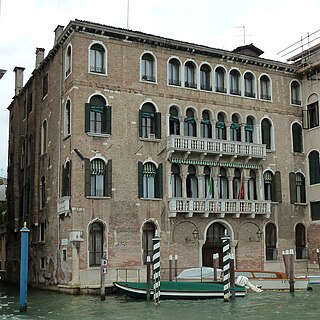
The Palazzo Giustiniani Businello is Gothic-style palace located on the Grand Canal, in the Sestiere of San Polo, adjacent to the Palazzo Papadopoli, in Venice, Italy.

The Palazzo Pisani Gritti is a Venetian Gothic palazzo located on the north side of the Grand Canal, opposite the Church of the Salute, between the Campo del Traghetto and the Rio de l'Alboro, in the Sestieri of San Marco, Venice, Italy. It was the residence of Doge Andrea Gritti in the 16th century. It is now the Gritti Palace Hotel.
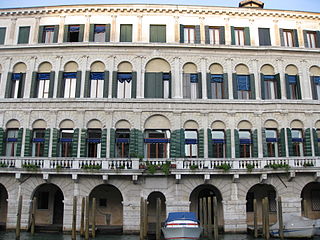
The Palazzo Moro Lin, also called the palace of 13 windows is a baroque-style palace on the Grand Canal, located between the Palazzo Grassi and the Palazzo da Lezze, in the sestiere of San Marco, in Venice, Italy.

The Palazzo Grimani Marcello, also known as Giustinian Querini is a Renaissance-style palace in located on the Grand Canal, between the Palazzo Querini Dubois and the Palazzo Cappello Layard in the sestiere of San Polo of Venice, Italy.

The Palazzo Pisani a Santo Stefano is a large palace located facing Campo Santo Stefano, in an alley near the facade of the church of San Vidal, in the sestiere of San Marco, in the city of Venice, Italy. The palace is owned by the city and now houses the Conservatorio di Musica Benedetto Marcello di Venezia, founded in 1876.

Palazzo Donà Balbi is a palace in Venice, Italy, located in the Santa Croce district, overlooking the right side of the Grand Canal on the Riva di Biasio foundation opposite Palazzo Flangini and the church of San Geremia.